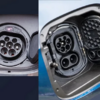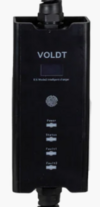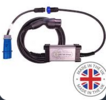If you want a copy you will have to contact the electrician; not the other bodies.
You are using an out of date browser. It may not display this or other websites correctly.
You should upgrade or use an alternative browser.
You should upgrade or use an alternative browser.
Feasibility of installing 7kw charger in powered garage (and granny charging fall back if not)
- Thread starter Gallo
- Start date
Sponsored Links
No. You can’t install 7kw charger at your garage without changes from the house to the garage
And then in the garage
And then in the garage
- Joined
- 13 Mar 2019
- Messages
- 960
- Reaction score
- 248
- Country

Not clear to me why the existing 13A socket in your garage isn't safe to charge from.1. In line charging would require some wiring changes to make it safe and unlikely to get super cheap tariff for EV charging. This will be expensive and approach the cost of a dedicated charger install.
I've never heard it called an "in-line charger". "Granny cable" is the usual jargon. And as other pedants like to point out, the charger is in the car. Also they usually come with the car, so I wouldn't anticipate needing to buy one separately.
Where are you getting 30hrs at 3kW from? That would imply a total charge of 90kWh...they never made a Zoe with a 90kWh battery. Charging is obviously not 100% efficient, but it's not that bad
A quick google suggests a Zoe has a 52kWh battery so you'd be looking at around 23h of charging from 0-100% [which you wouldn't want to do].
Not clear to me why the existing 13A socket in your garage isn't safe to charge from.
I've never heard it called an "in-line charger". "Granny cable" is the usual jargon. And as other pedants like to point out, the charger is in the car. Also they usually come with the car, so I wouldn't anticipate needing to buy one separately.
Where are you getting 30hrs at 3kW from? That would imply a total charge of 90kWh...they never made a Zoe with a 90kWh battery. Charging is obviously not 100% efficient, but it's not that bad
A quick google suggests a Zoe has a 52kWh battery so you'd be looking at around 23h of charging from 0-100% [which you wouldn't want to do].
Thanks for this. I'm probably not going to go ahead at the moment, but I'm very grateful for the advice as I really have no idea what I'm talking about.
This is where I got the info about the granny charger:https://www.evchargersdirect.co.uk/home-charging/
"Charging from a normal 3 pin socket - Mode 2 Charging
Firstly, there is what is called an ‘in line charger’ or ‘portable charger’ sometimes referred to as a ‘granny cable’. "The 52kWh Zoe does not come with a mode 2 cable as standard. It comes with a mode 3 type 2 cable. This is because Renault don't recommend using this method of charging for some reason.
The charging info came from the Autotrader estimate for the ad I was looking at:
Sponsored Links
Very few EVs are supplied with portable EVSEs (granny leads) anymore. Mode 2 charging isn't generally recommended as it can burn out the socket-outlet.Not clear to me why the existing 13A socket in your garage isn't safe to charge from.
I've never heard it called an "in-line charger". "Granny cable" is the usual jargon. And as other pedants like to point out, the charger is in the car. Also they usually come with the car, so I wouldn't anticipate needing to buy one separately.
Where are you getting 30hrs at 3kW from? That would imply a total charge of 90kWh...they never made a Zoe with a 90kWh battery. Charging is obviously not 100% efficient, but it's not that bad
A quick google suggests a Zoe has a 52kWh battery so you'd be looking at around 23h of charging from 0-100% [which you wouldn't want to do].
- Joined
- 27 Jan 2008
- Messages
- 25,302
- Reaction score
- 2,957
- Location
- Llanfair Caereinion, Nr Welshpool
- Country

Most of the problem with charging an EV is due to charging them outside. So since your charging in a garage there are not the same problems.
But home in UK are supplied with 60, 80, or 100 amp, and the fuse carrier is 100 amp even when only a 60 amp fuse fitted, so stage one is work out if you have spare power, and stage two does the DNO have spare power, we work on something called diversity, we do not expect all homes to draw high amps for a long time, my own home yesterday

Never used more than 3 kW, and this was normal, but use of both heat pumps and EV charging points has changed all this, I still use oil, so I charge the battery at around 2 kW for 1.5 hours each night, which is the highest load for the day. Mine turns on at 1 am, but if you had a street full of EV's all turning on at midnight, the chances are the system would not cope, so the normal EV charging point connects to the grid, so if too many are switched on together, they can reduce the load.
Not sure if the DNO turns down the charge rate or turns it off, but they have some control so if there is an overload they can reduce the load without turning your lights off.
So the government does not want wide spread use of the charging leads like this as they have no control other than turning off whole house, street, or area.
as they have no control other than turning off whole house, street, or area.
Most cars have one of these the bottom two pins are for DC so only used with fast chargers, the 7 pins often 2 pins missing
the bottom two pins are for DC so only used with fast chargers, the 7 pins often 2 pins missing
 so they can only use single phase, so max charge rate is 7 kW, with 3 phase 22 kW max. But a commando plug has no fuse, so does not get hot, but a 13 amp plug does, and fuses always get hot, so with a 13 amp plug the charge rate is only 10 amp so as not to over heat plug, commando plugs come as 16, 32, 64 amp and more, single and three phase, 110 and 230 volt to earth, but main thing is they can be used up to their rating for a long time without over heating.
so they can only use single phase, so max charge rate is 7 kW, with 3 phase 22 kW max. But a commando plug has no fuse, so does not get hot, but a 13 amp plug does, and fuses always get hot, so with a 13 amp plug the charge rate is only 10 amp so as not to over heat plug, commando plugs come as 16, 32, 64 amp and more, single and three phase, 110 and 230 volt to earth, but main thing is they can be used up to their rating for a long time without over heating.
The box in the lead are not all the same, the protection is the main variation, 6 mA DC, loss of PEN, RCD, may or may not be included, so prices vary. Some
are not all the same, the protection is the main variation, 6 mA DC, loss of PEN, RCD, may or may not be included, so prices vary. Some  will allow you to swap and change the plug. Clearly using even a 16 amp commando plug will increase charge rate by 1/3 so I would be at least looking at a 16 amp socket, but
will allow you to swap and change the plug. Clearly using even a 16 amp commando plug will increase charge rate by 1/3 so I would be at least looking at a 16 amp socket, but
This varies, I only have 5 hours, so 195 miles range, in real terms likely 150 miles range so 22.5/5 = 4.5 so 150/4.5 = 33 miles, so if your daily use is 33 miles or less, then the 10 amp supply will likely be enough, same calculation with 16 amp gives 53.5 miles range.
Even the 32 amp your still only looking at 100 miles range.
However with a proper charging point, then you can have 7 instead of 5 hours charge, so you can fully recharge with off peak, and get a cheaper off peak supply. (Octopus instead of British Gas)
You have to do the maths, for me, retired, major town 56 miles return, so I would use a fair bit of peak power with 10 amp, I would need over 16 amp, as timers go hour at a time so unlikely to start bang on midnight, so I would want at least a 20 amp supply.
But home in UK are supplied with 60, 80, or 100 amp, and the fuse carrier is 100 amp even when only a 60 amp fuse fitted, so stage one is work out if you have spare power, and stage two does the DNO have spare power, we work on something called diversity, we do not expect all homes to draw high amps for a long time, my own home yesterday
Never used more than 3 kW, and this was normal, but use of both heat pumps and EV charging points has changed all this, I still use oil, so I charge the battery at around 2 kW for 1.5 hours each night, which is the highest load for the day. Mine turns on at 1 am, but if you had a street full of EV's all turning on at midnight, the chances are the system would not cope, so the normal EV charging point connects to the grid, so if too many are switched on together, they can reduce the load.
Not sure if the DNO turns down the charge rate or turns it off, but they have some control so if there is an overload they can reduce the load without turning your lights off.
So the government does not want wide spread use of the charging leads like this
 as they have no control other than turning off whole house, street, or area.
as they have no control other than turning off whole house, street, or area.Most cars have one of these
 the bottom two pins are for DC so only used with fast chargers, the 7 pins often 2 pins missing
the bottom two pins are for DC so only used with fast chargers, the 7 pins often 2 pins missing The box in the lead
 are not all the same, the protection is the main variation, 6 mA DC, loss of PEN, RCD, may or may not be included, so prices vary. Some
are not all the same, the protection is the main variation, 6 mA DC, loss of PEN, RCD, may or may not be included, so prices vary. Some  will allow you to swap and change the plug. Clearly using even a 16 amp commando plug will increase charge rate by 1/3 so I would be at least looking at a 16 amp socket, but
will allow you to swap and change the plug. Clearly using even a 16 amp commando plug will increase charge rate by 1/3 so I would be at least looking at a 16 amp socket, butSo convert to amp hour at 230 volt so 226 amps for one hour, although likely 1.5 hours is fastest it can charge at, or 7 hours at 32 amp, 14 hours at 16 amp, or 17 hours at 13 amp, or 22.5 hours at 10 amp. But this is looking at a dead battery to start with, so this will not happen. But what we want is for it to charge within the off peak available.A quick google suggests a Zoe has a 52kWh battery
This varies, I only have 5 hours, so 195 miles range, in real terms likely 150 miles range so 22.5/5 = 4.5 so 150/4.5 = 33 miles, so if your daily use is 33 miles or less, then the 10 amp supply will likely be enough, same calculation with 16 amp gives 53.5 miles range.
Even the 32 amp your still only looking at 100 miles range.
However with a proper charging point, then you can have 7 instead of 5 hours charge, so you can fully recharge with off peak, and get a cheaper off peak supply. (Octopus instead of British Gas)
You have to do the maths, for me, retired, major town 56 miles return, so I would use a fair bit of peak power with 10 amp, I would need over 16 amp, as timers go hour at a time so unlikely to start bang on midnight, so I would want at least a 20 amp supply.
You're not suggesting our beloved BS1363 sockes are not fit for purpose, are you?Very few EVs are supplied with portable EVSEs (granny leads) anymore. Mode 2 charging isn't generally recommended as it can burn out the socket-outlet.
That's not the purpose for which they were designed in fairness.You're not suggesting our beloved BS1363 sockes are not fit for purpose, are you?
- Joined
- 27 Jan 2008
- Messages
- 25,302
- Reaction score
- 2,957
- Location
- Llanfair Caereinion, Nr Welshpool
- Country

They have been altered since they first came out, the line pin on the plug, is now reduced in size so insulation can be put on the pin, so it does not sink the heat as well as it use to, the cable used to wire them reduced from 2.7 mm² to 2.5 mm² and the brown and black bakelite replaced with lighter colours less able to radiate the heat, and also less able to stand the heat.You're not suggesting our beloved BS1363 sockes are not fit for purpose, are you?
Yes they were designed we are told to allow homes to be electrically heated, however they must have had a large cheek to put their tongue in, dad's old post war house, 6 rooms, so if a 3 kW fire in each room, that's 78 amps and main fuse 60 amp. And only one ring final which had a 30 amp fuse. So 30/6=5 amp per room, so 1200 watt per room, with remember no double glazing, steel window frames, and no thermostatic control. House built 1954 only 4 rooms had fire places, master bedroom, living room and dinning room, and aga in the kitchen, which in winter was never allowed to go out, one as only way to get a cup of tea (coffee unheard of then) and darn cold if it when out.
The BS 1363 socket is really good, but not really fit any more for what it is claimed it was designed for.
Forgive me for being ignorant; what exactly were BS1363 connectors designed for if it wasn't for powering 13A loads?That's not the purpose for which they were designed in fairness.
Not for long durations.Forgive me for being ignorant; what exactly were BS1363 connectors designed for if it wasn't for powering 13A loads?

13A EV Sockets Compliant with BS 1363-2 EV
Weatherproof BS 1363-2 EV compliant high quality single socket designed for the connection of a granny charger. BS 1363-2/EV
With respect, my experience of BS1363 connectors has always been that they have never matched the performance of BS546 and is precisely the reason that public entertainment clung onto them rather than moving to the 'newer plugs'. Personally I don't believe the different colours or reduction of metal has made much, if any, difference. I believe the major failing has been the reduction of quality due to costsaving, such as MK outsourcing to some 'unpredictable' manufacturing service.They have been altered since they first came out, the line pin on the plug, is now reduced in size so insulation can be put on the pin, so it does not sink the heat as well as it use to, the cable used to wire them reduced from 2.7 mm² to 2.5 mm² and the brown and black bakelite replaced with lighter colours less able to radiate the heat, and also less able to stand the heat.
Yes they were designed we are told to allow homes to be electrically heated, however they must have had a large cheek to put their tongue in, dad's old post war house, 6 rooms, so if a 3 kW fire in each room, that's 78 amps and main fuse 60 amp. And only one ring final which had a 30 amp fuse. So 30/6=5 amp per room, so 1200 watt per room, with remember no double glazing, steel window frames, and no thermostatic control. House built 1954 only 4 rooms had fire places, master bedroom, living room and dinning room, and aga in the kitchen, which in winter was never allowed to go out, one as only way to get a cup of tea (coffee unheard of then) and darn cold if it when out.
The BS 1363 socket is really good, but not really fit any more for what it is claimed it was designed for.
Personally I still use a stock of very old 'Bill' sockets for my portable/temporary services wherever I can and the only failure I've had with them in 50 years has been physical damage as opposed to modern products of which I've changed many tens, I expect into triple figures with a majority being electrical failures or overheating.
I'd love to know where that is stated in the BS, I'll bet you can't find it.Not for long durations.
Not clear to me why the existing 13A socket in your garage isn't safe to charge from.
Using a granny-charger, the OP would not have much access to off-peak charging rates, if that might be important?
DIYnot Local
Staff member
If you need to find a tradesperson to get your job done, please try our local search below, or if you are doing it yourself you can find suppliers local to you.
Select the supplier or trade you require, enter your location to begin your search.
Please select a service and enter a location to continue...
Are you a trade or supplier? You can create your listing free at DIYnot Local
Sponsored Links
Similar threads
- Replies
- 10
- Views
- 1K
